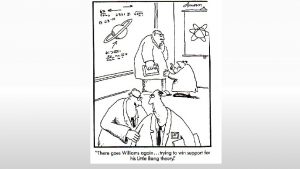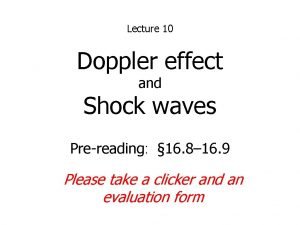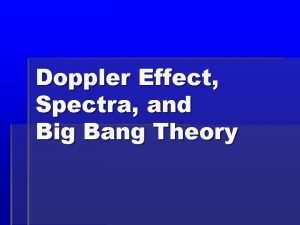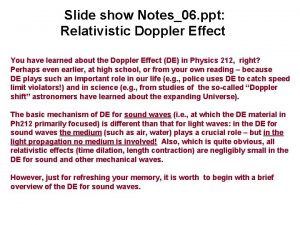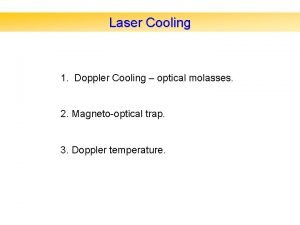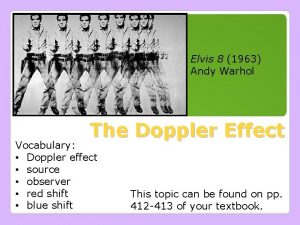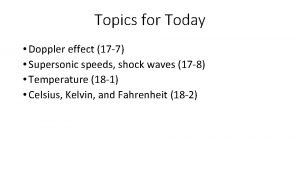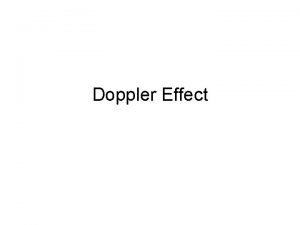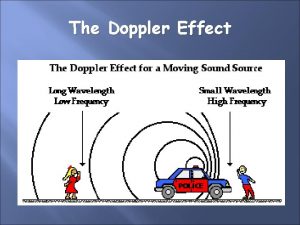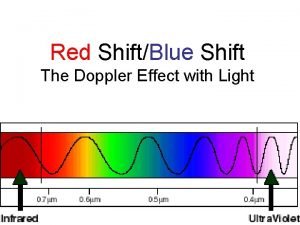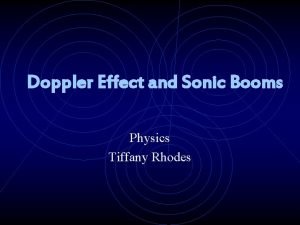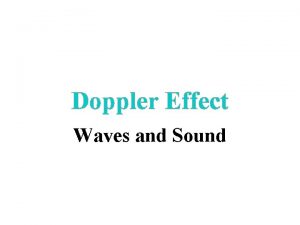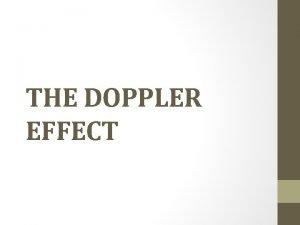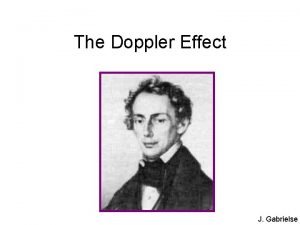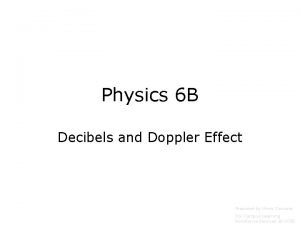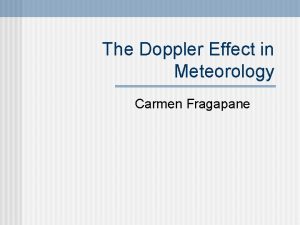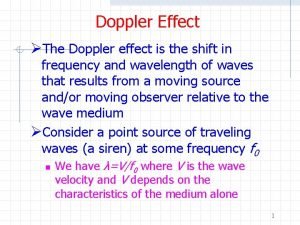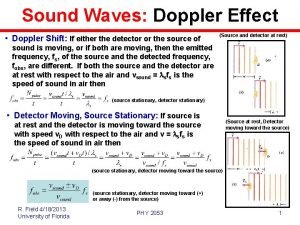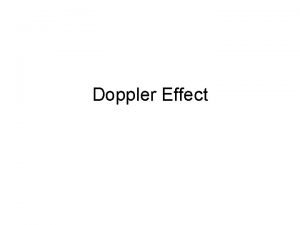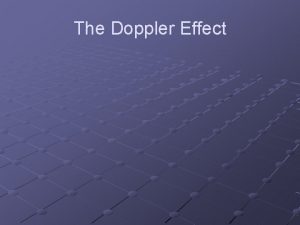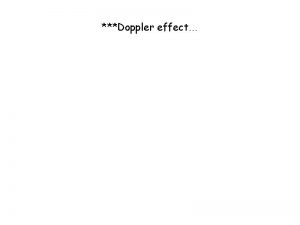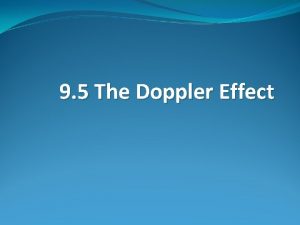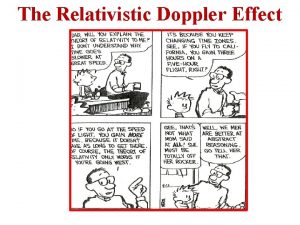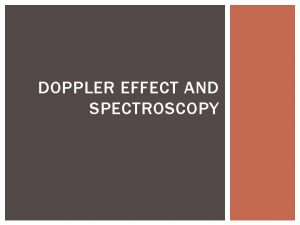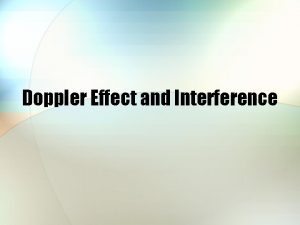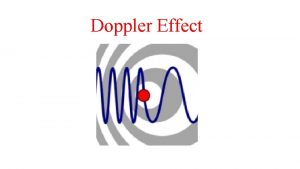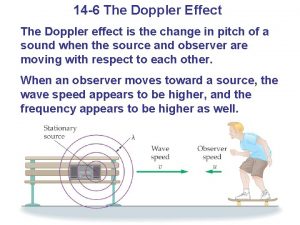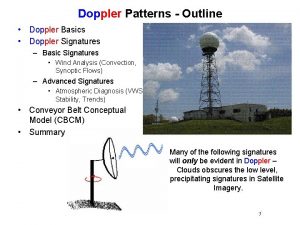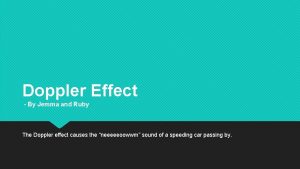The Doppler Effect The Doppler effect is the



















- Slides: 19

The Doppler Effect The Doppler effect is the shift in frequency of a wave that occurs when the wave source, or the detector of the wave, is moving. Applications range from medical tests using ultrasound to police speed traps using radar to astronomy (with electromagnetic waves).

Both source and observer are at rest Consider a stationary source of sound broadcasting a singlefrequency sound wave. The usual relationship between frequency, speed, and wavelength is: v represents the speed of sound through the medium.

Doppler effect: a moving observer When you move toward the source, you encounter more waves per unit time than you did before. Observer and source at rest Observer moving, source at rest

A moving observer Let's say you, the observer, move toward a stationary source with speed vo. You encounter more waves per unit time than you did before. What has changed, in effect, for the waves? 1. their speed 2. their wavelength

From the observer’s perspective For you, the entire pattern is traveling toward you, unchanged. Moving observer and source at rest, but from the observer’s reference frame Observer and source at rest

A moving observer Relative to you, the waves travel at a higher speed: If you move away from the source, the relative speed between you and the waves would be lower. In either case, this shifts the frequency of the waves you hear, to: Use the top sign (+) when the observer moves toward the source, and the bottom sign (-) when the observer moves away.

A moving observer If you move away from the source, the observed frequency is less than the source frequency. Observer and source at rest Observer moving, and source at rest

Doppler effect: a moving source If the source moves through the medium, the situation looks a little different.

A moving source You, a stationary observer, are near a source that is moving with speed vs. What changes, in effect, for the waves in this case? 1. their speed 2. their wavelength

A moving source The motion of the source effectively changes the wavelength, to: Use the top sign (-) when the source moves toward the observer, and the bottom sign (+) when it moves away. The detected frequency is:

The Doppler Effect in general In some situations, both the source and the observer move. The general Doppler equation combines the previous results. For both sets of signs, use the first sign when the motion is toward the other thing, and the second sign when the motion is away.

A sample Doppler problem A particular bat emits ultrasonic waves with a frequency of 56. 0 k. Hz. The bat is traveling at 20. 0 m/s toward a moth, which is hovering motionless in the air. The speed of sound is 340. 0 m/s. (a) Assuming the moth could detect the waves, what frequency waves would it observe? (b) The waves reflect off the moth and are detected by the bat. What frequency are the waves detected by the bat?

A sample Doppler problem (a) The observed frequency is:

A sample Doppler problem When the waves reflect from the moth, the moth becomes the source and the bat becomes the observer. (a) The observed frequency is:

Breaking the sound barrier If the source travels at the speed of sound, the waves pile up and move along with the source. All the peaks are at the same place, so the wavelength is zero and the frequency is infinite. This overlay of all the waves produces a shock wave known as a sonic boom.

Breaking the sound barrier When a jet goes through the sound barrier, there are regions of very high pressure and very low pressure. In the low pressure region at the back of the jet, the air expands, cools, and water vapor condenses to form a cloud.

Breaking the sound barrier When the source moves faster than the wave speed, the source outruns the wave. The waves now pile up along a particular angle, again producing a shock wave (sonic boom). The angle at which the shock wave moves away from the path of the source depends on the speed of the source relative to the speed of sound. Does the pattern look familiar?

Breaking the sound barrier Does the pattern look familiar? It looks a lot like the wake left behind by a boat moving through water. What does this tell you about how a boat's speed compares to the speed of water waves?

A child on a swing A child is swinging back and forth on a playground swing. A speaker in front of the child is broadcasting a singlefrequency tone. At which point in the swing does the child perceive the tone to be of lowest frequency, and of highest frequency? 1. The frequency is lowest at 1, and highest at 5. 2. The frequency is lowest at 5, and highest at 1. 3. The frequency is lowest at 1 and 5, and highest at 3. 4. The frequency is highest at 1 and 5, and lowest at 3. 5. The frequency is both lowest and highest at point 3.
 Doppler effect bbc bitesize
Doppler effect bbc bitesize Doppler effect
Doppler effect Doppler effect
Doppler effect What is the evidence of the big bang
What is the evidence of the big bang Relativistic doppler effect ppt
Relativistic doppler effect ppt Doppler effect
Doppler effect Magneto optical trap
Magneto optical trap Doppler effect
Doppler effect Doppler effect
Doppler effect Doppler effect in sound
Doppler effect in sound Doppler effect
Doppler effect Redshifted
Redshifted Doppler effect youtube
Doppler effect youtube Doppler effect formula
Doppler effect formula Doppler effect when to add or subtract
Doppler effect when to add or subtract Whats happening in this picture
Whats happening in this picture Decibel equation
Decibel equation Doppler effect meteorology
Doppler effect meteorology Doppler effect in light
Doppler effect in light Doppler effect
Doppler effect

